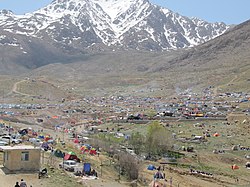Hafshejan
Hafshejan
Persian: هفشجان | |
|---|---|
City | |
 | |
| Coordinates: 32°13′37″N 50°47′35″E / 32.22694°N 50.79306°E[1] | |
| Country | Iran |
| Province | Chaharmahal and Bakhtiari |
| County | Shahrekord |
| District | Central |
| Population (2016)[2] | |
| • Total | 21,352 |
| Time zone | UTC+3:30 (IRST) |
| Website | www |
Hafshejan (Persian: هفشجان)[a] is a city in the Central District of Shahrekord County, Chaharmahal and Bakhtiari province, Iran. Hafshejan has existed for around 9,000 years.[4]
Demographics
[edit]Ethnicity
[edit]The city is populated by Persians.[5][6]
Population
[edit]At the time of the 2006 National Census, the city's population was 20,042 in 5,171 households.[7] The following census in 2011 counted 20,847 people in 6,062 households.[8] The 2016 census measured the population of the city as 21,352 people in 6,655 households.[2]
Zaneh Hafshejan fountain walkway
[edit]Hafshejan walkway is in the Jahanbin mountain range and is located 2 km from Hafshejan and 20 km from Shahr-e Kord. On Nature Day each year, more than 10 thousand people visit the park fountain.[9]
A walkway extends from the main Tourist attraction near the current centre of Chaharmahal and Bakhtiari Province, Shahr-e Kord.
Water is routed from the fountain to the agricultural plains 20 kilometres south of Branch and north of the mountain barrier between the world and 3 km from the city. The earthen dam has a clay core, and the reservoir has a volume of 1.3 million cubic meters. The dam crest's length is 410 m and the crest's width is 8 m, with a height of 42 meters in the deepest area.[10]
Elamite brick
[edit]
The Hafshejan Elamite brick carries the ancient scrolls of Chaharmahal and Bakhtiari Province. After the inscription is written Hafshejan. This brick has a width of 15 cm, a diameter of 8 cm, and has 26 lines. It was created more than 3100 years ago (1120 BC. M.). The brick was discovered in the province of Chaharmahal and Bakhtiari Province in the afternoon Elamite shows[11]
Gallery
[edit]-
The oldest lions made of stone in Hafshejan
-
A 6000-year-old inscription in Hafshejan
See also
[edit]Notes
[edit]References
[edit]- ^ OpenStreetMap contributors (2 April 2023). "Hafshejan, Shahrekord County" (Map). OpenStreetMap (in Persian). Retrieved 2 April 2023.
- ^ a b "Census of the Islamic Republic of Iran, 1395 (2016)". AMAR (in Persian). The Statistical Center of Iran. p. 14. Archived from the original (Excel) on 24 May 2019. Retrieved 19 December 2022.
- ^ Hafshejan can be found at GEOnet Names Server, at this link, by opening the Advanced Search box, entering "-3065354" in the "Unique Feature Id" form, and clicking on "Search Database".
- ^ Zagarell, A. (1982). The Prehistory of the Northeast Bakhtiari Mountains, Iran “The Rise of a Highland Way of Life
- ^ "Language distribution: Chahar Mahal va Bakhtiari Province". Iran Atlas. Retrieved 25 March 2021.
- ^ Anonby, Erik. "Atlas of the Languages of Iran: A working classification". Iran Atlas. Retrieved 27 March 2021.
- ^ "Census of the Islamic Republic of Iran, 1385 (2006)". AMAR (in Persian). The Statistical Center of Iran. p. 14. Archived from the original (Excel) on 20 September 2011. Retrieved 25 September 2022.
- ^ "Census of the Islamic Republic of Iran, 1390 (2011)". Syracuse University (in Persian). The Statistical Center of Iran. p. 14. Archived from the original (Excel) on 16 January 2023. Retrieved 19 December 2022.
- ^ "چهارمحال و بختیاری بام ایران ، سرزمین هزار چشمه + تصاویر - اخبار تسنیم - Tasnim". خبرگزاری تسنیم - Tasnim (in Persian). Retrieved 8 May 2018.
- ^ «چهارمحال و بختیاری بام ایران، سرزمین هزار چشمه + تصاویر»
- ^ "Archived copy". Archived from the original on 22 August 2016. Retrieved 10 July 2016.
((cite web)): CS1 maint: archived copy as title (link)
| Capital | |||||||||||||||||||||||
|---|---|---|---|---|---|---|---|---|---|---|---|---|---|---|---|---|---|---|---|---|---|---|---|
| Counties and cities |
| ||||||||||||||||||||||
| Landmarks |
| ||||||||||||||||||||||
| populated places | |||||||||||||||||||||||
| Capital | |||||||||||||||||||||||||||||||||||||||||
|---|---|---|---|---|---|---|---|---|---|---|---|---|---|---|---|---|---|---|---|---|---|---|---|---|---|---|---|---|---|---|---|---|---|---|---|---|---|---|---|---|---|
| Districts |
| ||||||||||||||||||||||||||||||||||||||||
Text is available under the CC BY-SA 4.0 license; additional terms may apply.
Images, videos and audio are available under their respective licenses.




